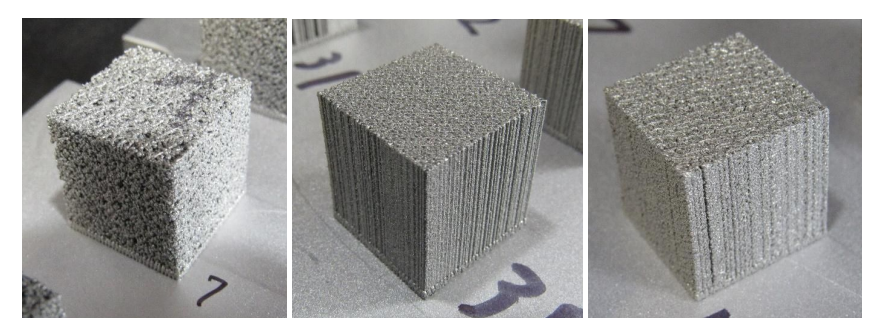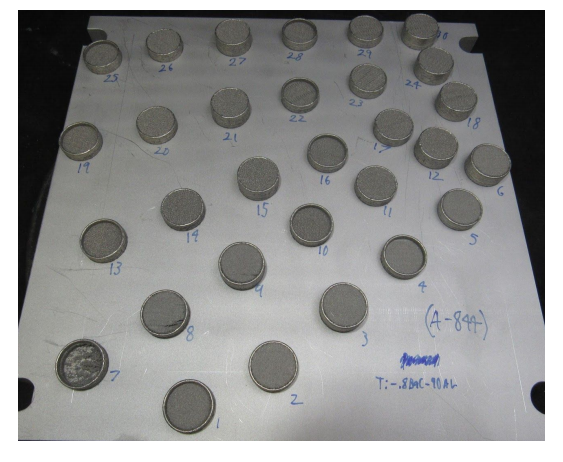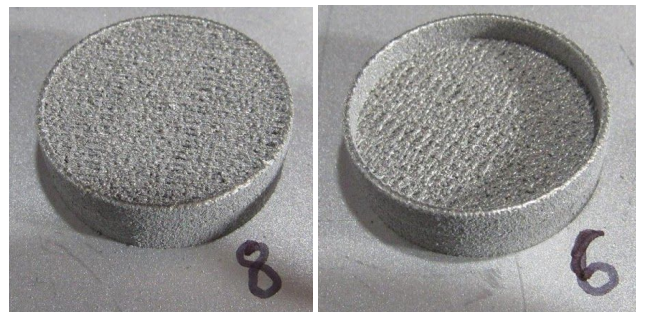In the recently published ‘PermiAM: Porous Additively Manufactured L-PBF Flow Property Characterization for Rocket Engines,’ technological researchers from both Masten Space Systems and Elementum3D outline a new additive manufacturing process for laser powder bed fusion (L-PBF) that offers exponential savings in engine development. PermiAM enables open porosity in situ with ‘fully dense material.’
Meant to assist in creating complex rocket engine injectors with face cooling, PermiAM cuts down on development time as well as overall cost in production. The production team tested three different materials in 22 engine runs:
- A1000-RAM10 aluminum
- A1000-RAM10 aluminum with a Type III hard anodization on the injector face
- Pure copper
Samples for the project included test cubes using A1000-RAM10, as the researchers tested pore generation, along with a set of 30 test pucks to evaluate air flow.

Cube A-791-7 utilizing the first strategy attempted. 74.7% relative density and 13.2% open porosity. (left). Cube A-800-38 utilizing second strategy, which produces a narrow channeling through the part. 88.3% relative density and 5.4% open porosity. (center). Cube A-805-15 utilizing third strategy, which produces a more tortuous channeling through the part. 76.5% relative density and 17.2% open porosity. (right)
“One important success with these initial puck builds was the ability to reliably and repeatedly build fully dense support rings around test samples of widely varied porosity,” stated the authors. “This is important for injector faceplate builds and also provides benefits beyond rocket engine structures to components such as jet engine turbine blades and fluid filtration components.
“Another main focus of the design was to provide an inlet profile for the air flow to reach the porous medium with minimal disturbance. This required a tight tolerance between the ends of the two threaded sections to avoid any large gap or flow disturbances at the connection.”
Sample holders were fabricated during these 3D printing experiments with Formlabs Tough resin using a Formlabs Form 2 SLA printer. Ultimately, the research analysis showed that the design ‘should function without failure.’ Testing was complex for this study, and one of the most important evaluations for the researchers was putting PermiAM under pressure in rocket engine conditions. This required hot-firing with a single element test stand for material validation.
“Originally developed to test single coaxial elements for 25,000 lbf thrust OX/Methane thrust chambers, the test stand runs at a chamber pressure up to 5.86 MPa (850 psi) and generates up to 445 N (100 lbf) of thrust. Under nominal running conditions, the injector face temperatures did not exceed 50°C, and often stayed below 10°C,” concluded the researchers.
“Under nominal running conditions, the injector face temperatures did not exceed 50°C, and often stayed below 10°C. The injectors also survived chamber pressures over 5.52 MPa (800 psig). This performance demonstrates that PermiAM is technically viable for use in injectors; this has applications for both NASA and commercial uses.”
Whether you are seriously interested in aerospace applications or not, rockets and the idea of space travel are still pretty spectacularly exciting. And when accompanied by 3D printing technology, they are even more so—from FDM printing of rocket grains to techniques for printing liquid rockets to researchers creating new rocket alloys. What do you think of this news? Let us know your thoughts! Join the discussion of this and other 3D printing topics at 3DPrintBoard.com.
[Source / Images: ‘PermiAM: Porous Additively Manufactured L-PBF Flow Property Characterization for Rocket Engines’]Subscribe to Our Email Newsletter
Stay up-to-date on all the latest news from the 3D printing industry and receive information and offers from third party vendors.
Print Services
Upload your 3D Models and get them printed quickly and efficiently.
You May Also Like
3D Printing News Briefs, July 2, 2025: Copper Alloys, Defense Manufacturing, & More
We’re starting off with metals in today’s 3D Printing News Briefs, as Farsoon has unveiled a large-scale AM solution for copper alloys, and Meltio used its wire-laser metal solution to...
3DPOD 260: John Hart on VulcanForms, MIT, Desktop Metal and More
John Hart is a Professor at MIT; he´s also the director of the Laboratory for Manufacturing and Productivity as well as the director of the Center for Advanced Production Technologies....
3D Printing News Briefs, June 28, 2025: Defense Accelerator, Surgical Models, & More
In this weekend’s 3D Printing News Briefs, 3YOURMIND was selected to join an EU Defense Accelerator, and PTC has announced model-based definition (MBD) capabilities within Onshape. Finally, a study out...
EOS in India: AM’s Rising Star
EOS is doubling down on India. With a growing base of aerospace startups, new government policies, and a massive engineering workforce, India is quickly becoming one of the most important...





































